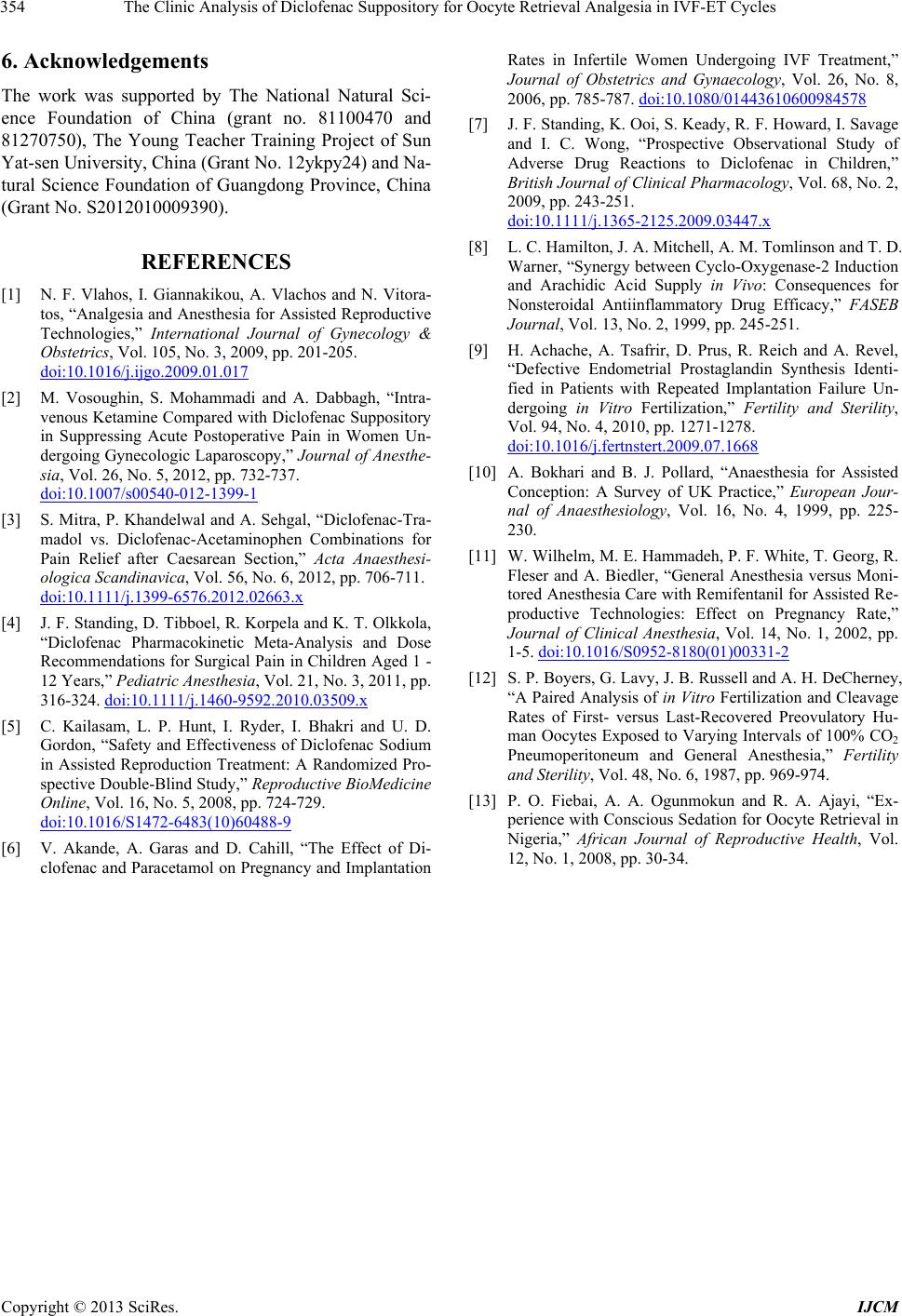
The Clinic Analysis of Diclofenac Suppository for Oocyte Retrieval Analgesia in IVF-ET Cycles
354
6. Acknowledgements
The work was supported by The National Natural Sci-
ence Foundation of China (grant no. 81100470 and
81270750), The Young Teacher Training Project of Sun
Yat-sen University, China (Grant No. 12ykpy24) and Na-
tural Science Foundation of Guangdong Province, China
(Grant No. S2012010009390).
REFERENCES
[1] N. F. Vlahos, I. Giannakikou, A. Vlachos and N. Vitora-
tos, “Analgesia and Anesthesia for Assisted Reproductive
Technologies,” International Journal of Gynecology &
Obstetrics, Vol. 105, No. 3, 2009, pp. 201-205.
doi:10.1016/j.ijgo.2009.01.017
[2] M. Vosoughin, S. Mohammadi and A. Dabbagh, “Intra-
venous Ketamine Compared with Diclofenac Suppository
in Suppressing Acute Postoperative Pain in Women Un-
dergoing Gynecologic Laparoscopy,” Journal of Anesthe-
sia, Vol. 26, No. 5, 2012, pp. 732-737.
doi:10.1007/s00540-012-1399-1
[3] S. Mitra, P. Khandelwal and A. Sehgal, “Diclofenac-Tra-
madol vs. Diclofenac-Acetaminophen Combinations for
Pain Relief after Caesarean Section,” Acta Anaesthesi-
ologica Scandinavica, Vol. 56, No. 6, 2012, pp. 706-711.
doi:10.1111/j.1399-6576.2012.02663.x
[4] J. F. Standing, D. Tibboel, R. Korpela and K. T. Olkkola,
“Diclofenac Pharmacokinetic Meta-Analysis and Dose
Recommendations for Surgical Pain in Children Aged 1 -
12 Years,” Pediatric Anesthesia, Vol. 21, No. 3, 2011, pp.
316-324. doi:10.1111/j.1460-9592.2010.03509.x
[5] C. Kailasam, L. P. Hunt, I. Ryder, I. Bhakri and U. D.
Gordon, “Safety and Effectiveness of Diclofenac Sodium
in Assisted Reproduction Treatment: A Randomized Pro-
spective Double-Blind Study,” Reproductive BioMedicine
Online, Vol. 16, No. 5, 2008, pp. 724-729.
doi:10.1016/S1472-6483(10)60488-9
[6] V. Akande, A. Garas and D. Cahill, “The Effect of Di-
clofenac and Paracetamol on Pregnancy and Implantation
Rates in Infertile Women Undergoing IVF Treatment,”
Journal of Obstetrics and Gynaecology, Vol. 26, No. 8,
2006, pp. 785-787. doi:10.1080/01443610600984578
[7] J. F. Standing, K. Ooi, S. Keady, R. F. Howa rd, I. Savage
and I. C. Wong, “Prospective Observational Study of
Adverse Drug Reactions to Diclofenac in Children,”
British Journal of Clinical Pharmacology, Vol. 68, No. 2,
2009, pp. 243-251.
doi:10.1111/j.1365-2125.2009.03447.x
[8] L. C. Hamilton, J. A. Mitchell, A. M. Tomlinson and T. D.
Warner, “Synergy between Cyclo-Oxygenase-2 Induction
and Arachidic Acid Supply in Vivo: Consequences for
Nonsteroidal Antiinflammatory Drug Efficacy,” FASEB
Journal, Vol. 13, No. 2, 1999, pp. 245-251.
[9] H. Achache, A. Tsafrir, D. Prus, R. Reich and A. Revel,
“Defective Endometrial Prostaglandin Synthesis Identi-
fied in Patients with Repeated Implantation Failure Un-
dergoing in Vitro Fertilization,” Fertility and Sterility,
Vol. 94, No. 4, 2010, pp. 1271-1278.
doi:10.1016/j.fertnstert.2009.07.1668
[10] A. Bokhari and B. J. Pollard, “Anaesthesia for Assisted
Conception: A Survey of UK Practice,” European Jour-
nal of Anaesthesiology, Vol. 16, No. 4, 1999, pp. 225-
230.
[11] W. Wilhel m, M. E. Hammade h, P. F. White, T. Georg, R.
Fleser and A. Biedler, “General Anesthesia versus Moni-
tored Anesthesia Care with Remifentanil for Assisted Re-
productive Technologies: Effect on Pregnancy Rate,”
Journal of Clinical Anesthesia, Vol. 14, No. 1, 2002, pp.
1-5. doi:10.1016/S0952-8180(01)00331-2
[12] S. P. Boyers, G. Lavy , J. B. Russell and A. H. DeCherney,
“A Paired Analysis of in Vitro Fertilization and Cleavage
Rates of First- versus Last-Recovered Preovulatory Hu-
man Oocytes Exposed to Varying Intervals of 100% CO2
Pneumoperitoneum and General Anesthesia,” Fertility
and Sterility, Vol. 48, No. 6, 1987, pp. 969-974.
[13] P. O. Fiebai, A. A. Ogunmokun and R. A. Ajayi, “Ex-
perience with Conscious Sedation for Oocyte Retrieval in
Nigeria,” African Journal of Reproductive Health, Vol.
12, No. 1, 2008, pp. 30-34.
Copyright © 2013 SciRes. IJCM